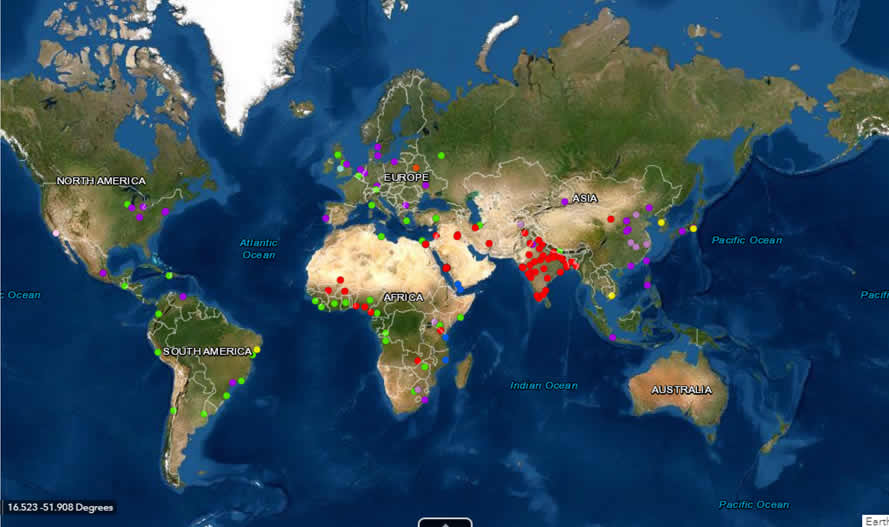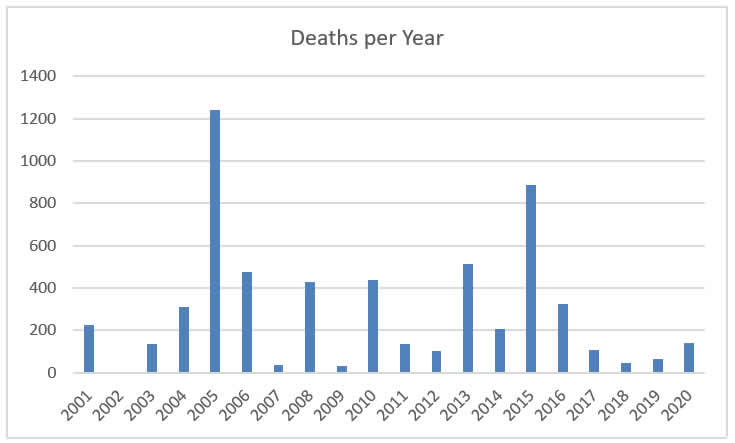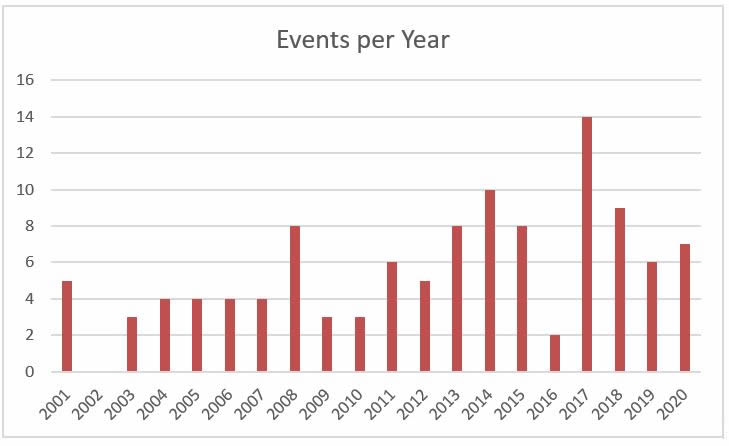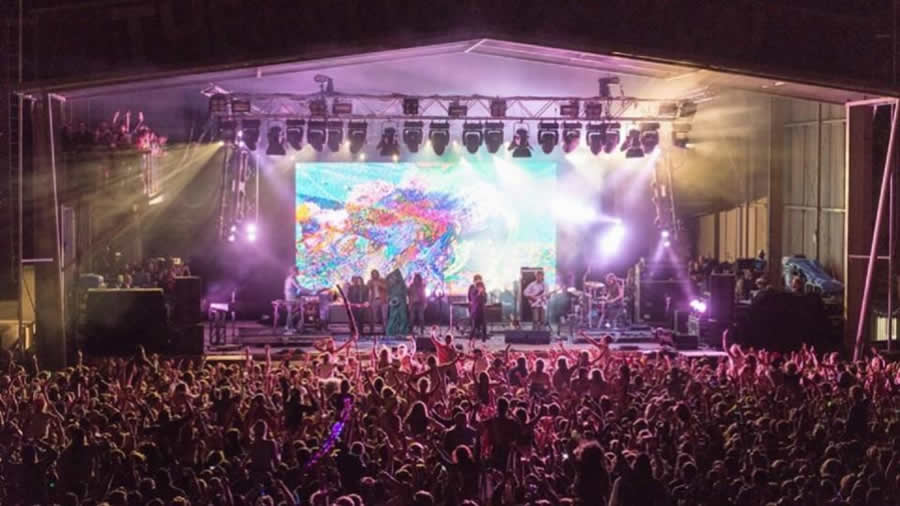Behaviour and Mechanics of Crowd Crush Disasters
Introduction
Large concentrations of people occur frequently in modern society. Usually these large gatherings of people occur without serious problems. Occasionally the combination of inadequate facilities and deficient crowd management results in injury and death, as occurred most recently in the Meron, Israel religious festival on 30 April 2021 which left 45 people dead. Crowd “mis”behaviour is usually not the primary cause of crowd disasters (Fruin, 1993; Still, 2019; Helbing and Mukerji, 2012). Sensational headlines using pejorative words like “panic,” “stampede” and “trampling” obscure the systematic failure of organisations to provide a safe environment for places of public assembly.
Several notable crowd crush events have been triggered by military activities in wartime, including one noted below, and it seems likely that natural disaster events could similarly trigger crown crush events. Although this review has not found documentation of such events they may well exist. This survey may provide useful insight into human behaviour in the course of emergency evacuation following natural disasters.
Fruin (1993) proposed a simple model with the acronym “FIST” to provide a basic understanding of crowd disasters. The acronym elements are defined as the crowd Force (F); the Information (I) upon which the crowd acts; the physical Space (S) involved, both in relationship to individual density and larger scale architectural features; and Time (T), the duration of the incident. The model is used to illustrate crowd characteristics and to develop guidelines for the prevention of crowd disasters. It is concluded that real time information and communication are key factors in preventing crowd disasters.
Regarding information, Fruin (2002) notes that psychologists have likened a crowd to a series of intermeshing behavioral cells. Each cell is comprised of a small group of surrounding people, with limited communication between the cells. Cell members do not have a broad view of what is occurring in the crowd. A dominant cell member may influence the collective behavior of the cell. Chains of cell-to-cell communication can occur, often with the spread of rumours and incorrect information, potentially inciting inappropriate behaviour.
The mechanics of crowd crush disasters
Once people are pushed tightly against one another (about seven people per square metre), those in the front need to keep moving as quickly as those behind them, because the people in the back, unable to see the front of the crowd, will move forward seeking more space, assuming that those in the front will continue to move to make way for them. If, for some reason, the speeds become mismatched because something is blocking the front of the group, or a rumour is spreading in the back that people are being crushed, this may cause people to speed up. In this case, the front of the group gets squeezed, sometimes producing enough force to crush people where they stand.
Smaller crushes may not be fuelled by “panic” at all — people can be crushed by the weight of those around them without anyone consciously surging forward. Blaming the behavior of “the crowd” is usually a mistake, since most crushes can probably be attributed to the physical limits of their location (Still, 2019). Even crushes or stampedes that occur at rowdier events, like soccer games, store sales and music festivals, are more likely due to physical strain than they are to any specific human behavior.
Crowd forces can reach levels that are almost impossible to resist or control. Virtually all crowd deaths are due to compressive asphyxia and not the “trampling” reported by the news media (although trampling is a common cause of death in animals). Evidence of bent steel railings after several fatal crowd incidents shows that forces of more than 4500N (1,000lbs) occurred. Forces are due to pushing, and the domino effect of people leaning against each other.
Compressive asphyxia can occur from people being stacked up vertically, one on top of the other, or from horizontal pushing and leaning forces. In the Ibrox Park soccer stadium incident in Glasgow in 1971, police reported that the pile of bodies was 3m high. At this height, people on the bottom would experience chest pressures of 3600-4000N (800-900lbs).
However, most victims in these events die standing up (Gill and Landi, 2004). Horizontal forces sufficient to cause compressive asphyxia are more dynamic as people push off against each other to obtain breathing space. In the Cincinnati rock concert incident, a line of bodies was found approximately 9m from a wall near the entrance. This indicates that crowd pressures probably came from both directions as rear ranks pressed forward and front ranks pushed off the wall.
Experiments to determine concentrated forces on guardrails due to leaning and pushing have shown that forces of 30% to 75% of participant weight can occur. In a US National Bureau of Standards study of guardrails, three persons exerted a leaning force of 792N (178lbs) and 609N (137lbs) pushing (Fattal et al., 1976). In a similar Australian Building Technology Centre study (National Building Technology Centre, date unknown), three persons in a combined leaning and pushing posture developed a force of 1370N (306 lbs). This study showed that under a simulated “panic,” five persons were capable of developing a force of 3430N (766lbs) (Fruin, 1993).
The space
There are many examples of poor, and even hazardous, human environments resulting from a lack of understanding of the traffic flow relationships and space requirements of pedestrians. Although it is common for maximum pedestrian capacity to be used as a basis for design, analysis of time-lapse photography of pedestrian traffic flow on walkways and stairs has shown that capacity is reached when there is a dense crowding of pedestrians, causing restricted and uncomfortable motion. Insufficient consideration of human space requirements has resulted in inadequate design of many areas where pedestrians may be required to accumulate in large groups. In some instances, overcrowding of these areas has resulted in injury and loss of life (Fruin, 1971).
Stairways can be especially hazardous. In 1943 during World War II, 173 people died of compressive asphyxia and 92 were injured in a London Underground air raid shelter after someone fell on a lower level entry stair. Excited by the sounds of bombing, people at the surface continued to press forward. This resulted in a tangled mass of humanity on the stair that took rescuers 3 hours to unravel.
Human behaviour
Many crowd crushes result from a compression from two opposing flow rates exceeding the safe capacity of the space, and once that starts, it may be already too late to stop the incident escalating. In a tightly packed crowd, people become victims of their biology. The typical “fight or flight” panic response that accompanies a surge of adrenaline is harmful. If the thousands of people vying for space could remain calm and collected, crowd crushes would not occur. But faced with death, most people suffer a racing heartbeat and hyperventilation, and an urge to move to safety at any cost.
To prevent crown crushes, it is important to predict the movement that a crowd will want to take. Crowd managers need to bear in mind the speed and direction in which the crowd is likely to move, based on the nature of the activity involved in the gathering. Otherwise, frustrated behaviours are created that can send shock waves through a tightly packed crowd.
Social media could potentially enhance situational awareness in crowd crush conditions, especially by providing an overview of the crowd. However, social media could potentially also be used to spread false rumours. Moreover, it has been reported in several disasters that there is often overload of the mobile phone network and that the noise level makes communication difficult.
Geographical and activity distribution of crowd crush disasters
The geographical distribution of crowd crush disasters by various activities is shown in Figure 1 based on a catalogue of events by Asgary (2021). The largest numbers of events are attributable to religious (red), entertainment (purple) and sporting (green) activities. About one-quarter of the deaths between 2001 and 2020 occurred at three events at the Hajj pilgrimage in Mecca, Saudi Arabia, and many of the sporting events have occurred at soccer (football) matches.
A more complete catalogue of events compiled by Wikipedia (2021) has been used to examine the temporal and size distribution for the period between 2001 and 2021. Before 2001, that catalogue appears to be quite incomplete, but it seems to be complete since 2021 as shown below.

Temporal variation
As shown in Figures 2 and 3, there have been no events with more than 56 deaths since 2016, and from 2017 to 2020 the average annual deaths have been 90 compared with 350 between 2001 and 2016. This has occurred despite the fact that the number of events per year has increased (from 5 to 8). This decrease in annual deaths would not be expected if there were under-reporting of events in the earlier years. It seems possible that social media may be helping with situational awareness, but no clear evidence of this has been found.



Size distribution of crowd crush events
The size distribution of crowd crush events is shown in Figure 4. The median number of deaths is about 15 and the average number of deaths is about 50. The most frequent events are not the smallest events, but instead are events that involve the deaths of 15 people. The departure from linearity of the ranking of events by size suggests that there may be physical factors that constrain the distribution at the lower and upper ends. The relative paucity of small events may be related to the size of the behavioural cells as described above (Fruin, 2002), and the relative paucity of very large events may be related to the limited dimensions of the spaces used for public assembly.
Crowd crush events in Australia
Several crowd crush events have occurred at outdoor music festivals in Australia, but there has been only one known death, which occurred on January 26, 2001 at Sydney’s Olympic Park during Limp Bizkit’s headline set. At 9:23pm, security officials in yellow polo shirts, standing at the front of the mosh pit, signaled for singer Fred Durst to stop the music, stating that some people at the front of the crowd were having problems. Durst told the crowd to help one another, but also criticised the promoters over the mic. Security guards started pulling people out of the crowd. Within minutes of the start of the set, St John Ambulance staff were treating unconscious people at the side of the stage. Dozens were on stretchers and a few were transferred to hospital. The mosh pit was later described as “hot like a sauna” and “wild like standing in the surf in a rough swell”. Many people were knocked to the ground. At about 9:30pm, 16-year-old Jessica Michalik was removed unconscious from the crowd and later died. A crowd crush was narrowly averted at the corresponding event one year earlier.
Festival-goers were crushed, left gasping for air and unconscious during a chaotic crowd crush event at the Falls Festival (Figure 5) in Lorne on Victoria’s south-west coast on 30 December 2016 that left up to eighty people injured. There were no deaths but some suffered leg, rib, hip and pelvic fractures, head injuries and spinal injuries. Twenty people were taken to hospital with serious but not life-threatening injuries, and paramedics treated sixty people at the site for various injuries. The crush occurred as festival-goers tried to leave a performance by Australian rock band DMA’s shortly before 11:00pm. Police said that panic set in after several people at the front of the crowd lost their footing, slipped and fell.

Mitigation of crowd crush disasters
An understanding of crowd crush disasters as systemic failures is provided by Helbing and Mukerji (2012). Mitigation of crowd crush disasters needs to focus on planning and preparedness, on the space and on information. Planning, design and prevention guidelines are described by Fruin (1971, 1993, 2002), and crowd management guidelines for outdoor music festivals have been proposed by Raineri and Earl (2005). Admission should be controlled, and visitor counts should be automated where possible. Medical preparedness should include paramedic teams, and plans should be made for handling situations that quickly overwhelm the local resources by identifying triage stations and local hospitals. For the space, pressure points such as entry points, exits and stairwells should be clearly marked for crowd dispersion, while also providing reliable ingress routes for rescuers. In some spaces, one-way traffic may be needed to avoid congestion. Situational awareness should be established by robust communications systems. Communication failures can be avoided using cell phone override codes, dedicated landlines, and pre-arranged radio frequencies. Changes in Saudi Arabia after the 2006 Hajj disaster included expansion of the Jamarat Bridge, implementation of one-way traffic, automating visitor counts and systematic scheduling and routing programs (Ngai et al., 2009), but evidently were not sufficient to avert the loss of at least 769 lives in the 2015 Hajj.
References
Asgary, A. (2021). World crowd disaster map. https://yorku.maps.arcgis.com/apps/webappviewer/index.html?id=e7c52856187642e19bd227865393432c
Fattal, S.G., Cattaneo, L.E. (1976). Investigation of Guardrails for the Protection of Employees From Occupational Hazards. Nat. Bur. Stds. NBSIR 76-1139, 114 pp.
Fruin, J.J. (1971). Pedestrian planning and design. Metropolitan Association of Urban Designers and Environmental Planners
Fruin, J.J. (1993). The causes and prevention of crowd disasters. First International Conference on Engineering for Crowd Safety, London, England, March 1993.
Fruin, J.J. (2002). The causes and prevention of crowd disasters. Book.
Gill, J.R. and K. Landi (2004). Traumatic asphyxia deaths due to an uncontrolled crowd. Am. J. Forensic Med. Pathol. 25, 358-361.
Helbing, D., Mukerji, P. (2012). Crowd disasters as systemic failures: analysis of the Love Parade disaster. EPJ Data Sci. 1, 7. https://doi.org/10.1140/epjds7
National Building Technology Centre (year unknown). Horizontal Loading on Handrails. NBTC Tech. Rec 514, Nat.Tech. Centre, New South Wales.
Ngai, K.M., F. Burkle, A. Hsu and E. Hsu (2009). Human stampedes: a systematic review of historical and peer-reviewed sources. Disaster Medicine and Public Health Preparedness.
Rainieri, A. and C. Earl (2005). Crowd Management for Outdoor music festivals. J. Occup. Health Safety – Aust NZ 21 (3), 205-215.
Still, G.K. (2019) Introduction to crowd science. CRC Press.
Wikipedia (2021). https://en.wikipedia.org/wiki/List_of_human_stampedes_and_crushes#21st_century
About the author/s

Paul Somerville
Paul is Chief Geoscientist at Risk Frontiers. He has a PhD in Geophysics, and has 45 years experience as an engineering seismologist, including 15 years with Risk Frontiers. He has had first hand experience of damaging earthquakes in California, Japan, Taiwan and New Zealand. He works on the development of QuakeAUS and QuakeNZ.
